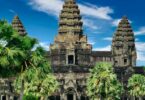Quiz about Taoism
Who is considered the founder of Taoism?
(a) Confucius
(b) Laozi
(c) Buddha
(d) Sun Tzu
Which half of The Yin and Yang symbol represents feminine, passive, and receptive aspects?
(a) Black (Yin)
(b) White (Yang)
What is the central concept that defines Taoism?
(a) The pursuit of material wealth
(b) The study of ancient scriptures
(c) The harmonious way of living by the Tao
(d) The worship of multiple deities
What is the critical difference between Taoism and Buddhism?
(a) Taoism emphasizes meditation and enlightenment, while Buddhism emphasizes living in harmony with the natural order.
(b) Buddhism originated in China, while Taoism originated in India.
(c) Taoism has a hierarchy of monks and nuns, while Buddhism does not.
(d) Buddhism strongly emphasizes following a strict moral code, while Taoism does not.
Which of the following practices is commonly associated with Taoism?
(a) Worshiping a pantheon of deities
(b) Daily prayer rituals
(c) Meditation and qi gong exercises
(d) Animal sacrifices
Related: Ancient Incense Trade Routes History Quiz
What is the central area of worship within a Taoist temple?
(a) The altar dedicated to Laozi
(b) The baptismal font
(c) The pulpit
(d) The choir loft
What is the ancient Chinese text that Taoists consult for divination and guidance, often associated with the concepts of Yin and Yang?
(a) The Analects
(b) The I Ching
(c) The Zhuangzi
(d) The Tao Te Ching
What core concept emphasizes living in harmony with the natural order and the Tao?
(a) Confucianism
(b) Wu Wei
(c) Karma
(d) Yin and Yang
What does the term “Tao” refer to?
(a) The religious texts of Taoism
(b) The path to enlightenment
(c) The ultimate reality or source of everything
What is a fundamental Buddhist concept that is not typically emphasized in Taoism?
(a) The Four Noble Truths
(b) The concept of karma
(c) The importance of meditation
(d) The practice of Wu Wei
Related: Religious Knowledge Quiz
What is the approximate timeframe for the origin of Taoism as a philosophical and spiritual tradition?
(a) 6th century BCE
(b) 2nd century CE
(c) 10th century CE
(d) 1st century BCE
Which of the following is a core belief in Taoism regarding human behavior and ethics?
(a) The importance of strict moral codes and rules
(b) The necessity of rigid social hierarchies
(c) The value of spontaneity, simplicity, and naturalness
Which of the following related to harmony with the Tao?
(a) The pursuit of wealth and material success
(b) The importance of rigid rules and regulations
(c) The concept of Wu Wei, or effortless action
(d) The rejection of all worldly pleasures
During which historical period did Taoism emerge as a prominent philosophical and spiritual tradition in China?
(a) The Han Dynasty (206 BCE – 220 CE)
(b) The Ming Dynasty (1368 – 1644 CE)
(c) The Tang Dynasty (618 – 907 CE)
(d) The Song Dynasty (960 – 1279 CE)
Where did Taoism originate?
(a) Panama
(b) China
(c) Japan
(d) Croatia
What is one commonality between Taoism and Confucianism?
(a) Both religions strongly emphasize rigid rituals and ceremonies.
(b) Both religions reject the concept of a higher power or deity.
(c) Both religions originated in India.
(d) Both religions advocate for the pursuit of knowledge and wisdom.
What is the most well-known and foundational text in Taoism?
(a) The Bible
(b) The Quran
(c) The Tao Te Ching
What fundamental concept represents the underlying principle and source of everything in the universe?
(a) Dharma
(b) Yin and Yang
(c) Karma
(d) Tao
Which historical figure is credited with organizing Taoist teachings and practices during the Tang Dynasty?
(a) Confucius
(b) Sun Tzu
(c) Zhuangzi
(d) Zhang Daoling
Related: China Han Dynasty Trivia & Questions
Where do Taoists typically engage in religious and spiritual practices?
(a) Temples and monasteries
(b) Synagogues
How does Taoism generally view the concept of an afterlife?
(a) It teaches a belief in reincarnation and karma.
(b) It emphasizes the pursuit of heaven as the ultimate goal.
(c) It does not focus on the afterlife; it values the present life and immortality.
(d) It teaches a belief in a single, all-powerful deity.
Which text is often attributed to Laozi?
(a) The Tao Te Ching
(b) The Analects
What is the primary difference between Taoism and Daoism?
(a) Taoism is the religious aspect, while Daoism refers to the philosophical aspect.
(b) Taoism is the English transliteration, while Daoism is the original Chinese term.
Related: Pirate trivia questions and answers
What is a fundamental difference between Taoism and Confucianism?
(a) Both emphasize rigid social hierarchies.
(b) Taoism promotes individual spontaneity, while Confucianism emphasizes social order and proper conduct.
What Taoist symbol represents the interplay of opposites and the balance of forces?
(a) Yin and Yang
(b) Lotus flower
What does the circle surrounding the Yin and Yang represent?
(a) The endless cycle of reincarnation
(b) The interconnectedness of all things
(c) The final goal of enlightenment
(d) The separation of opposing forces
How does Taoism typically view the concept of a personal deity or god?
(a) It emphasizes the worship of multiple gods.
(b) It promotes the worship of a single, all-powerful god.
(c) It does not focus on the worship of a personal god.
(d) It believes in a pantheon of deities.
When was the foundational Taoist text, the “Tao Te Ching,” believed to have been written?
(a) 500 BCE
(b) 221 BCE
(c) 221 CE
(d) 500 CE
Related: Angkor Wat Trivia Questions
Which of the following principles advocates embracing simplicity and avoiding excess?
(a) Yin and Yang
(b) Qi Gong
(c) The Five Elements
(d) The Three Treasures
What is the purpose of burning incense and making offerings at the altar in Taoist temples?
(a) To show reverence and seek blessings from ancestors and Taoist deities
(b) To achieve enlightenment through meditation
Which of the following best captures the essence of Taoism’s definition?
(a) A religious tradition with a strict moral code
(b) A philosophy emphasizing balance, naturalness, and the Tao
Which of the following is a similarity between Taoism and Buddhism?
(a) Both religions worship a single deity.
(b) Both religions originated in India.
(c) Both religions emphasize the importance of social hierarchy.
(d) Both religions encourage spiritual growth and self-realization.






